|
Hungarian People
| Hungarian People
http://en.wikipedia.org/wiki/Magyars |
Hungarians, also known as MagyarsHungarian:
magyar (singular);
magyarok (plural)are a nation
and ethnic
group who speak Hungarian
and are primarily associated with Hungary.
There are around 14-15 million Hungarians, of whom 10 million
live in today's Hungary (as of 2011).[19]
About 2.2 million Hungarians live in areas that were part of the
Kingdom
of Hungary before the 1918-1920 dissolution of the Austro-Hungarian
Monarchy and the Treaty
of Trianon, and are now parts of Hungary's seven
neighbouring countries, especially Romania,
Slovakia,
Serbia
and Ukraine.
Significant
groups of people with Hungarian ancestry live in various
other parts of the world, most of them in the United
States, Germany,
the United
Kingdom, Brazil,
Argentina,
Chile,
Canada
and Australia.
The Hungarians can be classified into several subgroups
according to local linguistic and cultural characteristics;
subgroups with distinct identities include the Székely,
the Csángó,
the Palóc,
and the Jassic
people.
Name
The exonym
"Hungarian" is thought to be derived from the Bulgar-Turkic
On-Ogur
(meaning "ten" Ogurs),[20]
which was the name of the Utigur
Bulgar
tribal confederacy that ruled the eastern parts of Hungary after
the Avars,
and prior to the arrival of Magyars. The Hungarians must have
belonged to the Onogur tribal alliance and it is quite possible
they became its ethnic majority.[20]
In the Early
Middle Ages the Hungarians had many different names, such as
"Ungar" or "Hungarus".[21]
The Hungarian people refer to themselves by the denomination
"Magyar", and not the term "Hungarian",
which is only used by non-Hungarians.[20]
The "H-" prefix is an addition in Medieval
Latin. The medieval
Kingdom of Hungary was known in Latin as either Regnum
Hungariae or as Regnum Ungariae.
The Hungarian endonym
is Magyar. There are several theories about the origin
and meaning of the word "Magyar".[
Ethnic
affiliations and genetic origins
The linguistic heritage of the Hungarians comes from Finno-Ugric
peoples. A branch of Uralic speakers migrated from their
original homeland near the Ural mountains and settled in
various places in eastern Europe, until they conquered the
present-day area of Hungary between the 9th and 10th centuries.
Genetically, the present-day Hungarian population preserves much
of an older European genetic makeup.[22][23]
In the Middle
Ages, according to genetic and palaeoanthropological
studies, the majority of Hungarians showed features of European
biological descent.[24][
Pre-fourth
century AD
During the fourth millennium BC, the Uralic-speaking
peoples who were living in the central and southern regions of
the Urals
split up. Some dispersed towards the west and northwest and came
into contact with Iranian speakers who were spreading
northwards.[26]
From at least 2000 BC onwards, the Ugrian speakers became
distinguished from the rest of the Uralic community. Judging by
evidence from burial mounds and settlement sites, they
interacted with the Andronovo
Culture,[27]
furthermore, the type of Hungarians of the Conquest period shows
related features to that of the Andronovo people.[28]
Fourth
century to c.830 AD
In the fourth and 5th centuries AD, the Magyars moved to the
west of the Ural Mountains to the area between the southern Ural
Mountains and the Volga
River known as Bashkiria (Bashkortostan)
and Perm
Krai.
In the early 8th century, some of the Magyars moved to the Don
River to an area between the Volga, Don and the Seversky
Donets rivers.[29]
Meanwhile, the descendants of those Magyars who stayed in Bashkiria
remained there as late as 1241.
The Magyars around the Don River were subordinates of the Khazar
khaganate.
Their neighbours were the archaeological Saltov
Culture, i.e. Bulgars
(Proto-Bulgarians, Onogurs)
and the Alans,
from whom they learned gardening, elements of cattle breeding
and of agriculture. Tradition holds that the Magyars were
organized in a confederacy of tribes called hétmagyar
(lit. seven Hungarians). The tribes of the hétmagyar
were: Jenő, Kér, Keszi, Kürt-Gyarmat,
Megyer, Nyék, and Tarján.
c.830
to c.895
Around 830, a civil war broke out in the Khazar
khaganate. As a result, three Kabar
tribes[30]
of the Khazars joined the Magyars and they moved to what the
Magyars call the Etelköz,
i.e. the territory between the Carpathians
and the Dnieper
River (today's Ukraine)[citation
needed]. Around 854, the Magyars faced a
first attack by the Pechenegs.[29]
(According to other sources, the reason for the departure of the
Magyars to Etelköz was the attack of the Pechenegs.) Both the
Kabars and earlier the Bulgars
may have taught the Magyars their Turkic
languages. The new neighbours of the Magyars were the Varangians
and the eastern Slavs.
From 862 onwards, the Magyars (already referred to as the Ungri)
along with their allies, the Kabars, started a series of looting
raids from the Etelköz
to the Carpathian Basinmostly against the Eastern
Frankish Empire (Germany) and Great
Moravia, but also against the Balaton
principality and Bulgaria.[31]
Entering
the Carpathian Basin (c.895)
In 895/896, under the leadership of Árpád,
some Hungarians crossed the Carpathians
and entered the Carpathian
Basin. The tribe called Megyer was the leading tribe of the
Hungarian alliance that conquered the centre of the basin. At the
same time (c.895), due to their involvement in the 894896
Bulgaro-Byzantine
war, Magyars in Etelköz were attacked by Bulgaria
and then by their old enemies the Pechenegs. The Bulgarians
won the decisive battle
of Southern Buh. It is uncertain whether or not those
conflicts were the cause of the Hungarian departure from Etelköz.
From the upper Tisza
region of the Carpathian Basin, the Hungarians intensified their
looting raids across continental Europe. In 900, they moved from
the upper Tisza river to Transdanubia (Pannonia)[citation
needed], which later became the core of the
arising Hungarian state. At the time of the Hungarian migration,
the land was inhabited only by a sparse population of Slavs,
numbering about 200,000,[29]
who were either assimilated or enslaved by the Hungarians.[29]
After the battle of Augsburg (955), the Hungarians stopped
their raids against Western Europe.
Many of the Hungarians, however, remained to the north of the
Carpathians after 895/896, as archaeological findings suggest
(e.g. Polish
Przemyśl).
They seem to have joined the other Hungarians in 900. There is
also a consistent Hungarian population in Transylvania,
the Székelys,
comprise 40% of the Hungarians
in Romania.[32][33]
The Székely people's origin, and in particular the time of their
settlement in Transylvania, is a matter of historical controversy.
History
after 900
Medieval Hungary controlled more territory than medieval
France, and the population of medieval Hungary was the third
largest of any country in Europe.
The Hungarian leader Árpád
is believed to have led the Hungarians into the Carpathian
Basin in 896. In 907, the Hungarians destroyed a Bavarian
army in the Battle
of Pressburg and laid the territories of present-day Germany,
France and Italy open to Hungarian raids. These raids were fast
and devastating. The Hungarians defeated Louis
the Child's Imperial Army near Augsburg
in 910. From 917 to 925, Hungarians raided through Basle,
Alsace,
Burgundy,
Saxony,
and Provence.[34]
Magyar expansion was checked at the Battle
of Lechfeld in 955. Although the battle at Lechfeld stopped
the Hungarian raids against Western
Europe, the raids on the Balkan
Peninsula continued until 970.[35]
Hungarian settlement in the area was approved by the Pope
when their leaders accepted Christianity,
and Stephen
I the Saint (Szent István) was crowned King of Hungary
in 1001. The century between the Magyars' arrival from the eastern
European plains and the consolidation of the Kingdom
of Hungary in 1001 was dominated by pillaging campaigns across
Europe, from Dania (Denmark)
to the Iberian
Peninsula (modern Spain and Portugal).[36]
After the country's acceptance into Christian Europe under Stephen
I, Hungary served as a bulwark against further invasions from the
east and south, especially against the Turks.
At this time, the Hungarian nation numbered between 25,000[37]
and 1,000,000 people.[29][38]
The name "Hungarian" has also a wider meaning, as it
once referred to all inhabitants of the Kingdom
of Hungary irrespective of their ethnicity.[39]
The first accurate measurements of the population of the
Kingdom of Hungary including ethnic composition were carried out
in 185051. There is a debate among Hungarian and non-Hungarian
(especially Slovak and Romanian)
historians about the possible changes in the ethnic structure
throughout history.
Some historians support the theory that the Magyars' proportion
in the Carpathian Basin was at an almost constant 80% during the Middle
Ages[40][41][42][43][44]
non Magyars numbered hardly more than 20% to 25% of the total
population[40]
and began to decrease only at the time of the Ottoman
conquest,[40][41][44]
reaching as low as around 39% in the end of the 18th century.
The decline of the Magyars was due to the constant wars, Ottoman
raids, famines and plagues during the 150 years of Ottoman rule.[40][41][44]
The main zones of war were the territories inhabited by the
Magyars, so the death toll attrited them at a much higher rate
than among other nationalities.[40][44]
In the 18th century their proportion declined further because of
the influx of new settlers from Europe, especially Slovaks,
Serbs,
Croats[citation
needed], and Germans.[40][41][44][45]
Droves of Romanians entered Transylvania during the same period.[41][45][46]
As a consequence of the Turkish occupation and the Habsburg
colonization policies, the country underwent a great change[citation
needed] in ethnic composition.[44]
Hungary's population more than tripled to 8 million between 1720
and 1787, however, only 39% of its people were Magyars, who lived
primarily in the centre of the country.[40][41][42]
Other historians, particularly Slovak and Romanian ones, tend
to argue that the drastic change in the ethnic structure
hypothesized by Hungarian historians in fact did not occur.
Therefore, the Magyars are supposed to have accounted only for
about 3040%[citation
needed] of the Kingdom's population since its
establishment. In particular, there is a fierce debate among
Magyar and Romanian historians about the ethnic composition of Transylvania
through the times; see Origin
of the Romanians.
In the 19th century, the proportion of Magyars in the Kingdom
of Hungary rose gradually, reaching over 50% by 1900 due to higher
natural growth and magyarization.
Between 1787 and 1910 number of ethnic Hungarians rose from 2.3
million to 10.2 million due to population
explosion, generated by the resettlement of the Great
Hungarian Plain and Voivodina
by mainly Roman
Catholic Hungarian settlers from the northern and western
counties of the Kingdom of Hungary. In 1715 (after the Ottoman
occupation) the Southern
Great Plain was near uninhabited, now has 1.3 million
inhabitants, and it's homogeneous with ethnic Hungarians.
Spontaneous assimilation was an important factor, especially
among the German and Jewish minorities and the citizens of the
bigger towns. On the other hand, about 1.5 million people (of whom
about two-thirds were non-Hungarian) left the Kingdom
of Hungary between 18901910 to escape from poverty.[47]
The years 1918 to 1920 were a turning point in the Magyars'
history. By the Treaty
of Trianon, the Kingdom had been cut into several parts,
leaving only a quarter of its original size. One third of the
Magyars became minorities in the neighbouring countries.[48]
During the remainder of the 20th century, the Magyar population of
Hungary grew from 7.1 million (1920) to around 10.4 million
(1980), despite losses during the Second
World War and the wave of emigration after the attempted revolution
in 1956. The number of Hungarians in the neighbouring
countries tended to remain the same or slightly decreased, mostly
due to assimilation (sometimes forced; see Slovakization
and Romanianization)[49][50][51]
and emigration to Hungary (in the 1990s, especially from Transylvania
and Vojvodina).
After the "baby
boom" of the 1950s (Ratkó era), a serious
demographic crisis began to develop in Hungary and its neighbours.[52]
The Magyar population reached its maximum in 1980, after which it
began to decline. This decline is expected to continue at least
until 2050, at which time the population will probably be between
8 and 9 million.[52]
Today, the Magyars represent around 35% of the population of
the Carpathian Basin, their number is around 1213 million. For
historical reasons (see Treaty
of Trianon), significant Hungarian
minority populations can be found in the surrounding countries,
most of them in Romania
(in Transylvania),
Slovakia,
Serbia
(in Vojvodina).
Sizable minorities live also in Ukraine
(in Transcarpathia),
Croatia
(primarily Slavonia)
and Austria
(in Burgenland).
Slovenia
is also host to a number of ethnic Hungarians, and Hungarian
language has an official status in parts of the Prekmurje
region. Today, more than two million ethnic Hungarians live in
nearby countries.[53]
There was a referendum
in Hungary in December 2004 on whether to grant Hungarian citizenship
to Magyars living outside Hungary's borders (i.e. without
requiring a permanent residence in Hungary). The referendum failed
due to insufficient voter
turnout. On May 26, 2010, Hungary's Parliament passed a bill
granting dual citizenship to ethnic Hungarians living outside of
Hungary. The neighboring countries with sizable Hungarian minority
expressed concerns over the legislation[54].
Later
influences
Besides the various peoples mentioned above, the
Magyars assimilated or were influenced by subsequent peoples
arriving in the Carpathian Basin. Among these are the Cumans,
Pechenegs,
Jazones,
Germans
and other Western European settlers in the Middle
Ages. Vlachs
(Romanians)
and Slavs
have lived together and blended with Magyars since early medieval
times. Ottomans,
who occupied the central part of Hungary from c.1526 until c.1699,
inevitably exerted an influence, as did the various nations (Germans,
Slovaks,
Serbs,
Croats
and others) that resettled depopulated territories after their
departure. Similar to other European countries, Jewish,
Armenians,
and Roma
(Gypsy) minorities have been living in Hungary since the Middle
Ages.
Hungarians in Greater
Hungary
(census 1890) |
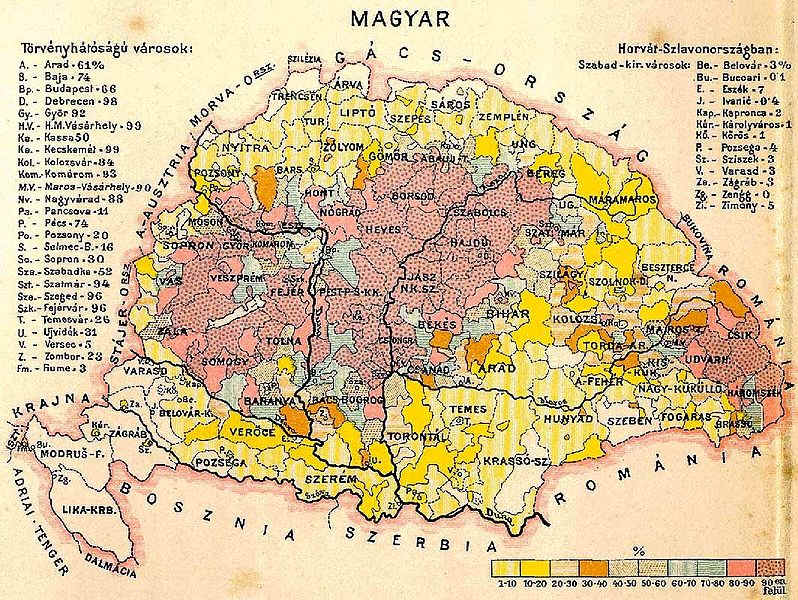 |
|
Traditional
costumes (17th and 18th century) |
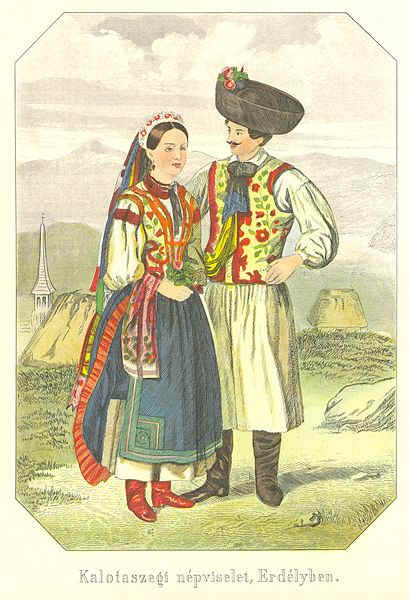 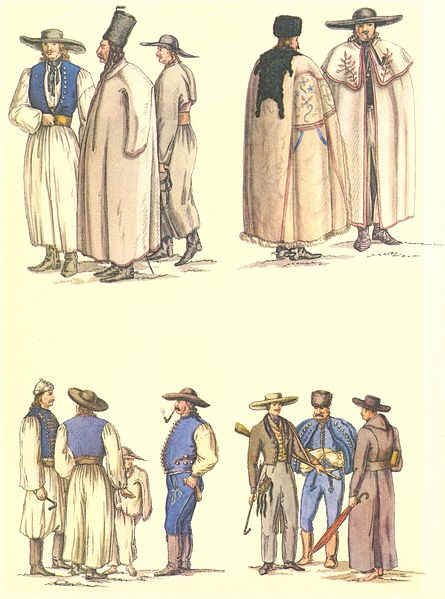
|
|
Traditional
costumes (17th and 18th century) |
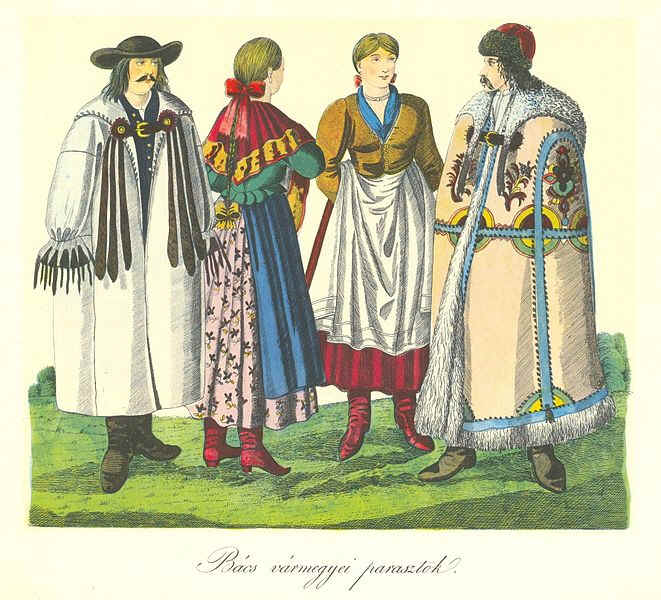
|
|
Traditional
costumes (17th and 18th century) |
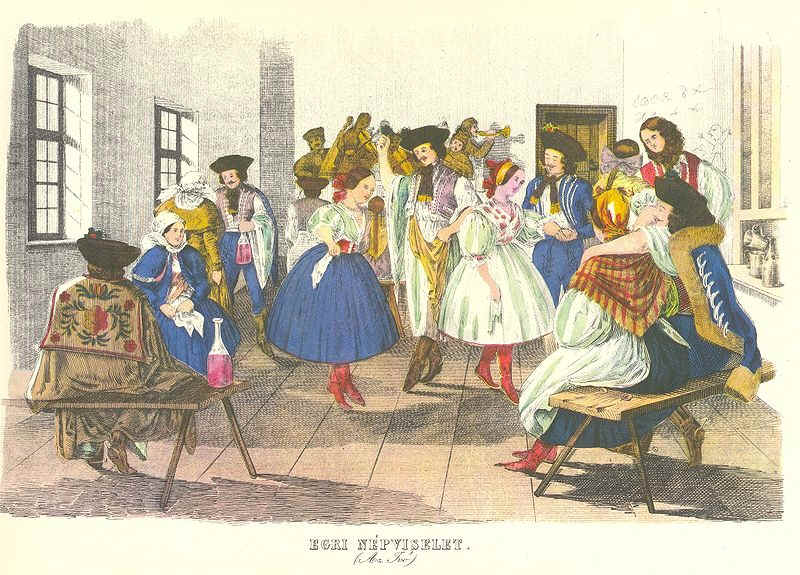
|
|
| Kingdom of
Hungary
http://en.wikipedia.org/wiki/Kingdom_of_Hungary |
The Kingdom of Hungary was a multilingual,
multiethnic
and (as the meaning from the 19th century) multinational[4]
country in Central
Europe covering what is today Hungary,
Slovakia,
Transylvania
(now part of Romania),
Carpathian
Ruthenia (now part of Ukraine),
Vojvodina
(now part of Serbia),
Burgenland
(now part of Austria),
and other smaller territories surrounding present-day Hungary's
borders. From 1102 it also included Croatia
(except Istria),
being in personal
union with it, united under the Hungarian king. The kingdom
existed for almost one thousand years (10001918 and
19201946) and at various points was regarded as one of the cultural
centers of the Western
world.
Names
The Latin
Regnum Hungariae/Vngarie
(Regnum meaning kingdom); Regnum
Marianum (Kingdom of St.
Mary); or simply Hungaria was the form used in official
Latin documents from the beginning of the kingdom to the 1840s.
The German
name (Königreich Ungarn)
was used from 1849 to the 1860s, and the Hungarian
name (Magyar Királyság)
was used in the 1840s, and again from the 1860s to 1918. The names
in other languages of the kingdom were: Polish:
Królestwo Węgier,
Romanian:
Regatul Ungariei, Croatian:
Kraljevina Ugarska, Slovene:
Kraljevina Ogrska, Czech:
Uherské království,
Slovak:
Uhorské kráľovstvo,
Italian
(for the city of Fiume),
Regno d'Ungheria.
In Austria-Hungary
(18671918), the unofficial name Transleithania was
sometimes used to denote the regions covered by the Kingdom of
Hungary. Officially, the term Lands of the Holy Hungarian Crown
of Saint Stephen was included for the Hungarian part of the
Austro-Hungarian Empire, although this term was also in use prior
to that time.
History
From 9 BC to the end of the 4th century, Pannonia
was part of the Roman
Empire on a part of later Hungary's area. Among the first to
arrive were the Huns,
who built up a powerful empire under Attila
the Hun. After Hunnish rule faded away, the Germanic Ostrogoths
and then the Lombards
came to Pannonia, and the Gepids
had a presence in the eastern part of the Carpathian
Basin for about 100 years. In the 560s the Avars
founded the Avar
Khaganate,[5]
a state which maintained supremacy in the region for more than two
centuries and had the military power to launch attacks against all
its neighbours. The Avar rule ended when the Khaganate was
conquered by the Franks
under Charlemagne
in the West and the Bulgarians
under Krum
in the East. The Hungarians
led by Árpád
conquered the Carpathian
Basin in 895. They led several successful incursions
to Western Europe, until they were was stopped by Otto
I, Holy Roman Emperor in Battle
of Lechfeld. In the Carpathian Basin the Hungarians conquered
an existing Slavonic
state of Great
Moravia weakened after the death of king Svatopluk
I. The force led by Árpád is estimated to have consisted of
from about 400,000 to about 600,000 people,[6]
consisting of seven Hungarian tribes, one Kabar tribe, and other
smaller tribes.[7]
Their newly founded Principality
of Hungary (8961000) was the first documented Hungarian
state in the Carpathian
Basin.[8]
The
Medieval Kingdom (10001538)
Árpád
dynasty
The first kings of the kingdom were from the Árpád
dynasty, and the first Christian King
was Stephen
I of Hungary who was canonized
as a Catholic
saint.
He fought against Koppány
and in 998, with Bavarian
help, defeated him near Veszprém.
The Roman Catholic Church received powerful support from
Stephen I, who with Christian Hungarians
and German knights wanted a Christian kingdom established in Central
Europe. It was he who created the Hungarian heavy cavalry[clarification
needed] as an example for Western European
powers.
After his death, a period of revolts and conflict for supremacy
ensued between the royalty and the nobles. In 1051 armies of the Holy
Roman Empire tried to conquer Hungary,
but they were defeated at Vértes
mountain. The armies of the Holy Roman Empire continued to
suffer defeats; the second greatest battle was at the town now
called Bratislava,
in 1052. Before 1052 Peter Orseolo, a supporter of the Holy
Roman Empire, was overthrown by king Samuel
Aba of Hungary.[9][10]
This period of revolts ended during the reign of Béla
I. Hungarian chroniclers praised Béla
I for introducing new currency, such as the silver denarius,
and for his benevolence to the former followers of his nephew,
Solomon. The terms Nobilissimus
(most noble) and nobilissima familia (most noble family) have
been used since the 11th century for the King of Hungary and his
family, but it were then only a few that were mentioned in
official documents as such.
The second greatest Hungarian king, also from the Árpád
dynasty, was Ladislaus
I of Hungary, who stabilized and strengthened the kingdom. He
was also canonized as a saint. Under his rule Hungarians
successfully fought against the Cumans and conquered Croatia
in 1091, due to a dynastic crisis in Croatia, he managed to
swiftly seize power in the kingdom, he also was a claimant to the
throne due to the fact that his sister was married to the late
Croatian king Zvonimir.
Although it is still debated among historians, it is believed that
Ladislaus created a kind
of personal union between the two kingdoms. However kingship
over all of Croatia would not be achieved until the reign of his
successor Coloman.[11][12][13][14][15]
The provinces of Croatia and Slavonia, and after 1868 the
autonomous province of Croatia-Slavonia
had autonomy within the Kingdom of Hungary from 10911918.[11][12][16][17][18]
Also, one of the greatest Hungarian jurists and statesmen of the
16th century, István
Werbőczy in his work Tripartitum treats Croatia as
a kingdom separate to Hungary. In 1222 Andrew
II of Hungary issued the Golden
Bull which laid down the principles of law.
Mongol
invasion
In 1241, Hungary was invaded by the Mongols
and while the first minor battles with Subutai's vanguard probes
ended in seeming Hungarian victories, the Mongols finally
destroyed the combined Hungarian and Cuman armies at the Battle
of Mohi.
The Mongols attacked Hungary with three armies, one of them
through Poland in order to withhold possible Polish
auxiliaries, and defeated the army of Duke Henry
II the Pious of Silesia
at the Legnica.
A southern army attacked Transylvania
defeating the voivod
and crushing the Transylvanian Hungarian[citation
needed] army. The main army led by Batu
Khan and Subutai
attacked Hungary through the fortified Verecke
Pass and annihilated the army led by the count
Palatine on 12 March 1241.[19]
Despite the appearance of the Mongol invasion having been a
surprise attack, the Hungarians
had known, from various sources, that the Mongols
were coming. Notable heralds of the oncoming invasion include the Friar
Julian group, which warned the king about impending invasion
it had established contact with Magna
Hungaria and saw the aftermath of the destruction of both the
Magna Hungaria and Volga
Bulgaria earlier in the 13th century.
In 1242, after the end of the Mongol
invasion, numerous fortresses to defend against future
invasion were erected by Béla
IV of Hungary. In gratitude, the Hungarians
acclaimed him as the "Second Founder of the Homeland",
and the Hungarian Kingdom again became a considerable force in
Europe. In 1260 Béla
IV lost the War of Babenberg Succession, his army was defeated
at Battle
of Kressenbrunn by the united Czech troops, however after in
1278, Ladislaus
IV of Hungary and Austrian troops fully destroyed the Czech
army at Battle
on the Marchfeld.
In 1301, with the death of Andrew
III of Hungary, the Árpád dynasty died out. The dynasty was
replaced by the Angevins,
followed by the Jagiellonians,
and then by several non-dynastic rulers, notably Sigismund,
Holy Roman Emperor and Matthias
Corvinus.
The
Anjou Age
When Ladislaus IV of Hungary died before Andrew III, another
nobleman reclaimed the throne for himself: Charles
Martel of Anjou, the son of the King Charles
II of Naples and Mary
of Hungary (the daughter of the king Stephen
V of Hungary). However Andrew III assured the power for
himself, and ruled without inconvenience after the death of Charles
Martel in 1295. When Andrew III died in 1301 the queen Mary of
Hungary, who raised Charles Martel's children, reclaimed the
throne of Hungary for her grandson Charles
Robert of Anjou who was 13 years old. Taking control after a
chaotic period, he was finally crowned as the king Charles
I of Hungary. He implemented considerable economic reforms,
and defeated the remaining nobility who were in opposition to
royal rule, led by Máté
Csák. The kingdom of Hungary reached an Age of prosperity and
stability under the rule of the king who had already learned the
language from his grandmother, and also knew Italian, Latin, and
French. The gold mines of the Kingdom were extensively worked and
soon Hungary reached a prominent place in European gold
production. The Hungarian
forint currency was introduced to replace the denars, and soon
after the reforms introduced by the King, the economy of the
Kingdom was placed again in a correct direction after its
disastrous state in the 13th century.
Charles I exalted the cult to the King Saint Ladislaus
I of Hungary, and used him as a symbol of bravery, justice,
purity (actually this monarch was Knight, King and Saint,
everything at the same time, something unusual), being the ideal
to follow. Charles I also venerated his uncle Saint
Louis of Toulouse, and on the other hand he gave importance to
the cult of the princess Saint
Margaret of Hungary and Saint
Elisabeth of Hungary, which became an instrument for the new
king, added relevance to the lineage inheritance through the
feminine branches, legitimizing himself with it.[20]
Charles I restored the royal power which had fallen into feudal
lords' hands, and then he made them swear loyalty to himself, the
new nobility that stood by his side. For this he founded in 1326
the Order
of Saint George, which was the first secular chivalric
order in the world, and included the most important noblemen
of the Kingdom.
After marrying three times and losing all his wives one after
the other, he took as his fourth wife the daughter of the Polish
King Władysław
I the Elbow-high: Elisabeth
of Poland. She gave him many children, most of them boys,
which assured the continuity of the family in the power. When
Charles I died in 1342, his eldest son succeeded him and was
crowned as Louis
I of Hungary. The new King followed his father's steps, being
advised closely by his mother, making the widow queen one of the
most influential personalities in the Kingdom.
Before Charles I's death, he had also arranged the marriage of
his other sons, Andrew,
Duke of Calabria with the queen Joan
I of Naples. However, the Queen, fearing that a stranger might
take control over his throne (actually both belonged to the same
royal family), started conspiring and ordered Andrew's murder. The
prince was killed in 1345, and almost immediately the King Louis
declared war on Naples and conduced a first campaign in 1347-48.
However, the war was interrupted by the rage of the very
contagious Black
Death, and the Hungarian armies went back home. Surprisingly
the Italians suffered many deaths and the Hungarians were barely
affected (the wife of Louis I died of it). Without giving himself
up, the Hungarian King resumed the war in 1349-50, conquering the
Kingdom of Naples. Seeing that keeping rule in both far states, he
signed a treaty with the Queen Joan I and left them independent.
Decades later, Louis I met with success on the battlefield when he
defended the Hungarian Kingdom from new attacks by lesser Mongol
forces in the latter half of the 14th century.
Louis I's uncle died in 1370, and after this the King of
Hungary also inherited the Kingdom of Poland, because the monarch
had no children that could succeed him in the throne. In the
beginning Louis was not widely accepted as Polish king, and the
nobility protested. Even the Widow Queen Elisabeth of Poland was
threatened, and his committee was executed when she visited
Poland, because she was not considered as Polish by his people.
However, pacting with the nobility, Louis became the new king of
the two states. A tragic event occurred a decade later. In 1382
Louis died, leaving no male heirs for both kingdoms, only two
daughters: Mary
of Hungary and Saint Jadwiga
of Poland.
The
Sigismund Age
Louis
I of Hungary always kept good and close relationships with the
Holy
Roman Emperor Charles
IV of Luxembourg. Louis considered Charles's son Sigismund
of Luxembourg to succeed him as King of Hungary. He named him
his heir and arranged the marriage with his daughter Mary
of Hungary. Sigismund lived in the court of Louis, and soon
learned the language and Hungarian way of life. However, the queen
consort Elizabeth
of Bosnia, mother of Mary and Jadwiga disliked the very young
prince's presence. After the death of Louis, the widowed Queen
made her best effort for Sigismund not to be crowned as King of
Hungary. This generated a chaotic period during which the little
Mary became queen of Hungary as her mother and the nobility
decided for her. Sigismund and Mary were married in 1385, but soon
he was sent away.
The Hungarian noblemen brought forth the King of Naples, Charles
of Anjou-Durazzo, who was the only living male relative to
Louis I of Hungary, and crowned him as Charles II of Hungary
in 1385. However, the Widow Queen and her advisors soon conspired
to regain power and Charles II was murdered in 1386. The enraged
people created disturbances, and the Widow Queen and Mary lost a
lot of adepts, They were eventually were captured and locked up in
a tower. The Widow Queen was strangled in 1387, and soon Mary was
released by Sigismund, who was crowned king of Hungary, having the
full support of the nobility.
Sigismund became a strong king who created many improvements in
the Hungarian law system and who rebuilt the palaces of Buda and
Visegrád. He brought materials from Austria and Bohemia and
ordered the creation of the most luxurious building in all central
Europe. In his laws can be seen the traces of the early mercantilism.
He worked hard to keep the nobility under his control.
A great part of his reign was dedicated to the fight with the
Ottoman empire, which started to extend its frontiers and
influence to Europe. In 1396 was fought the Battle
of Nicopolis against the Ottomans, which resulted in a defeat
for the Hungarian-French forces led by Sigismund and Philip
of Artois, Count of Eu. However, Sigismund continued to
successfully contain the Ottoman forces outside of the Kingdom for
the rest of his life.
Losing popularity among the Hungarian nobility, Sigismund soon
became victim of an attempt against his rule, and Ladislaus
of Anjou-Durazzo (the son of the murdered King of Naples
Charles II of Hungary) was called in and crowned. Since the
ceremony was not performed with the Hungarian Holy Crown, and in
the city of Székesfehérvár, it was considered illegitimate.
Ladislaus stayed only few days in Hungarian territory and soon
left it, no longer an inconvenience for Sigismund.
In 1408 he founded the Order
of the Dragon, which included the most of the relevant
monarchs and noblemen of that region of Europe in that time. This
was just a first step for what was coming. In 1410 he was elected King
of the Romans, making him the supreme monarch over the German
territories. He had to deal with the Hussite
movement, a religious reformist group that was born in Bohemia,
and he presided at the Council
of Constance, where the theologist founder Jan
Hus, was judged. In 1419 Sigismund inherited the Crown
of Bohemia after the death of his brother Wenceslaus
of Luxembourg, obtaining the formal control of three medieval
states, but he struggled for control of Bohemia until the peace
agreement with the Hussites and his coronation in 1436. In 1433
was crowned as Holy Roman Emperor by the Pope and ruled until his
death in 1437, leaving as his only heir his daughter Elizabeth
of Luxembourg and her husband. The marriage of Elizabeth was
arranged with the Duke Albert
V of Austria, who was later crowned as King Albert of
Hungary in 1437.
Hunyadi
family
The Hungarian kingdom's golden age was during the reign of Matthias
Corvinus, the son of John
Hunyadi. His nickname was "Matthias the Just". He
further improved the Hungarian economy and practised astute
diplomacy in place of military action whenever possible. Matthias
did undertake campaigning when necessary. In 1485, aiming to limit
the influence and meddling of the Holy Roman Empire in Hungary's
affairs, he occupied Vienna for 5 years. After his death, Vladislaus
II of Hungary of the Jagiellonians
was placed on the Hungarian throne.
At the time of the initial Ottoman encroachment, the Hungarians
successfully resisted conquest. John
Hunyadi was leader of the Long
Campaign in which the Hungarians
tried to expel the Turks from the Balkans. Initially, it was
successful, but finally they had to withdraw. In 1456 John
Hunyadi, the father of Matthias Corvinus, delivered a crushing
defeat on the Ottomans at the Siege
of Belgrade. The Noon
bell commemorates the fallen Christian warriors. In the 15th
century, the Black
Army of Hungary was a formidable modern mercenary army with
the Hussars
the most skilled troops of the Hungarian
cavalry. In 1479, under the leadership of Pál
Kinizsi, the Hungarian army destroyed the Ottoman and
Wallachian troops at the Battle
of Breadfield. The Army of Hungary destroyed its enemies
almost every time when Matthias was the king.
In 1526, at the Battle
of Mohács, the forces of the Ottoman
Empire annihilated the Hungarian army. In trying to escape Louis
II of Hungary drowned in the Csele Creek. The leader of the
Hungarian army, Pál
Tomori, also died in the battle.
Kingdom
of Hungary between 1538 and 1867
The
divided kingdom
Due to Ottoman pressure, central authority collapsed and a
struggle for power broke out. The majority of Hungary's ruling
elite elected János
Szapolyai (10 November 1526). A small minority of aristocrats
sided with Ferdinand
I, Holy Roman Emperor, who was Archduke of Austria,
and was related to Louis by marriage. Due to previous agreements
that the Habsburgs
would take the Hungarian throne if Louis died without heirs,
Ferdinand was elected king by a rump diet
in December 1526. The kingdom was divided between Szapolyai and
Ferninand I in 1538, according to the secret agreement of Nagyvárad.[21]
Although the borders shifted frequently during this period, the
three parts can be identified, more or less, as follows:
- Royal
Hungary, which consisted of northern and western
territories where Ferdinand I was recognized as king of
Hungary. This part is viewed as defining the continuity of the
Kingdom of Hungary. The territory along with Ottoman Hungary
suffered greatly from the nearly constant wars taking place.
- Ottoman
Hungary The Great
Alföld (i.e. most of present-day Hungary, including
south-eastern Transdanubia and the Banat),
partly without north-eastern present-day Hungary.
- Eastern
Hungarian Kingdom under the Szapolyai.
Note that this territory, often under Ottoman influence, was
different from Transylvania proper and included various other
territories sometimes referred to as Partium.
Later the entity was called Principality
of Transylvania.
On 29 February 1528, King John
I of Hungary received the support of the Ottoman Sultan. A
three-sided conflict ensued as Ferdinand moved to assert his rule
over as much of the Hungarian kingdom as he could. By 1529 the
kingdom had been split into two parts: Habsburg Hungary and the
"eastern-Kingdom of Hungary". At this time there were no
Ottomans on Hungarian territories, except Srem's important
castles. In 1532, Nikola
Juriić defended Kőszeg
and stopped a powerful Ottoman army. By 1541, the fall of Buda
marked a further division of Hungary into three areas. In the year
1542 Petar
Keglević the ban
of Croatia
and Slavonia
from 1537 to 1542 was sentenced as an infidel
by the Parliament in Bratislava,
because of his special agreement with the Ottoman
Empire. Even with a decisive 1552 victory over the Ottomans at
the Siege
of Eger, which raised the hopes of the Hungarians,
the country remained divided until the end of the 17th century.
The heroes' memory continues to live in a famous poem written by Sebestyén
Tinódi Lantos, Summáját írom Eger várának
("I am writing the history of Eger's castle"). Transylvania
evolved during the following centuries into a distinctive
autonomous unit within the Hungarian kingdom, with its special
voivode (or governor), its united, although heterogeneous,
leadership (descended from Szekler,
Saxon,
and Magyar
colonists), and its own constitution[22]
until 1526
when it effectively became independent[22]
In the following centuries there were numerous attempts to push
back the Ottoman
forces, such as the Long
War or Thirteen Years' War (29 July 1593 - 1604/11 November
1606) led by a coalition of Christian forces. In 1644 the Winter
Campaign by Miklós
Zrínyi burnt the crucial Suleiman Bridge of Osijek
in eastern Slavonia,
interrupting a Turkish supply line in Hungary.
At the Battle
of Saint Gotthard (1664), Austrians
and Hungarians
defeated the Turkish army.
After the Ottoman invasion of Austria failed in 1683, the
Habsburgs went on the offensive against the Turks. By the end of
the 17th century, they managed to conquer the remainder of the
historical Kingdom of Hungary and the principality of
Transylvania. For a while in 1686, the capital Buda
was again free, with European help.
The
Kuruc age
Rákóczi's War for Independence (17031711) was the first
significant freedom fight in Hungary against absolutist Habsburg
rule. It was fought by a group of noblemen, wealthy and
high-ranking progressives who wanted to put an end to the
inequality of power relations, led by Francis II Rákóczi (II. Rákóczi
Ferenc in Hungarian). Its main aims were to protect the rights of
the different social orders, and to ensure the economic and social
development of the country. Due to the adverse balance of forces,
the political situation in Europe and internal conflicts the
freedom fight was eventually suppressed, but it succeeded in
keeping Hungary from becoming an integral part of the Habsburg
Empire, and its constitution was kept, even though it was only a
formality.
After the departure of the Ottomans, the Habsburgs dominated
the Hungarian Kingdom. The Hungarians' renewed desire for freedom
led to Rákóczi's
War for Independence. The most important reasons of the war
were the new and higher taxes and a renewed Protestant movement. Rákóczi
was a Hungarian nobleman, son of the legendary heroine Ilona
Zrínyi. He spent a part of his youth in Austrian
captivity. The Kurucs were troops of Rákóczi. Initially,
the Kuruc
army attained several important victories due to their superior
light cavalry. Their weapons were mostly pistols, light sabre and fokos.
At the Battle
of Saint Gotthard (1705), János
Bottyán decisively defeated the Austrian army. The famous
Hungarian colonel Ádám
Balogh nearly captured Joseph
I, the King of Hungary and Emperor of Austria.
In 1708, the Habsburgs finally defeated the main Hungarian army
at Battle
of Trencsén, and this diminished the further effectiveness of
the Kuruc army. While the Hungarians
were exhausted by the fights, the Austrians
defeated the French army in the War
of the Spanish Succession. They could send more troops to Hungary
against the rebels. Transylvania became part of Hungary
again starting at the end of the 17th century, and was led by
governors.[23][24]
Age
of Enlightenment
In 1711, Austrian Emperor Charles
VI became the next ruler of Hungary. From this time on, the
designation Royal Hungary was abandoned, and the area was
once again referred to as the Kingdom of Hungary.[citation
needed] Throughout the 18th century, the
Kingdom of Hungary had its own Diet (parliament) and constitution,
but the members of the Governor's Council (Helytartótanács,
the office of the palatine)
were appointed by the Habsburg monarch, and the superior economic
institution, the Hungarian
Chamber, was directly subordinated to the Court
Chamber in Vienna.
The Hungarian Language reform started under reign of Joseph
II. The reform age of Hungary was started by István
Széchenyi a Hungarian noble, who built one of the greatest
bridges of Hungary, the Széchenyi
Chain Bridge. The official
language remained Latin
until 1844. Then, between 1844 and 1849, and from 1867, Hungarian
became the official language.
Hungarian
Revolution of 1848
The European revolutions of 1848 swept Hungary, as well. The
Hungarian Revolution of 1848 sought to redress the long suppressed
desire for political change, namely independence. The Hungarian
National Guard was created by young Hungarian patriots in 1848. In
literature, this was best expressed by the greatest poet of the
revolution, Sándor
Petőfi.
As war broke out with Austria, Hungarian military successes,
which included the brilliant campaigns of the great Hungarian
general, Artúr
Görgey, forced the Austrians on the defensive. One of the
most famous battles of the revolution, the Battle
of Pákozd, was fought on the 29 September 1848, when the
Hungarian revolutionary army led by Lieutenant-General János Móga
defeated the troops of the Croatian Ban Josip
Jelačić. Fearing defeat, the Austrians pleaded for
Russian help, which, combined with Austrian forces, quelled the
revolution. The desired political changes of 1848 were again
suppressed until Austro-Hungarian
Compromise of 1867.
Austria-Hungary
(18671918)
Following the Austro-Hungarian
Compromise of 1867, the Habsburg Empire became the "dual
monarchy" of Austria-Hungary.
The Austro-Hungarian economy changed dramatically during the
existence of the Dual Monarchy. Technological change accelerated
industrialization and urbanization. The capitalist way of
production spread throughout the Empire during its fifty-year
existence and obsolete medieval institutions continued to
disappear. By the early 20th century, most of the Empire began to
experience rapid economic growth. The GNP per capita grew roughly
1.45% per year from 1870 to 1913. That level of growth compared
very favorably to that of other European nations such as Britain
(1.00%), France (1.06%), and Germany (1.51%).
Treaty
of Trianon set in 1920
The new borders set in 1920 by the Treaty
of Trianon ceded 72% of the historically Hungarian territory
of the Kingdom of Hungary to the neighbouring states. The
beneficiaries were Romania,
the newly formed states of Czechoslovakia,
and the Kingdom
of Serbs, Croats and Slovenes. This left more than 3.5 million
ethnic Hungarians
outside the new borders. Many view this as contrary to the terms
laid out by US President Woodrow
Wilson's Fourteen
Points, which were intended to honour the ethnic makeup of the
territories.
See also
Web Links
|
Kingdom of Hungary ("Ungarn")
within Austria-Hungary, 1899. |
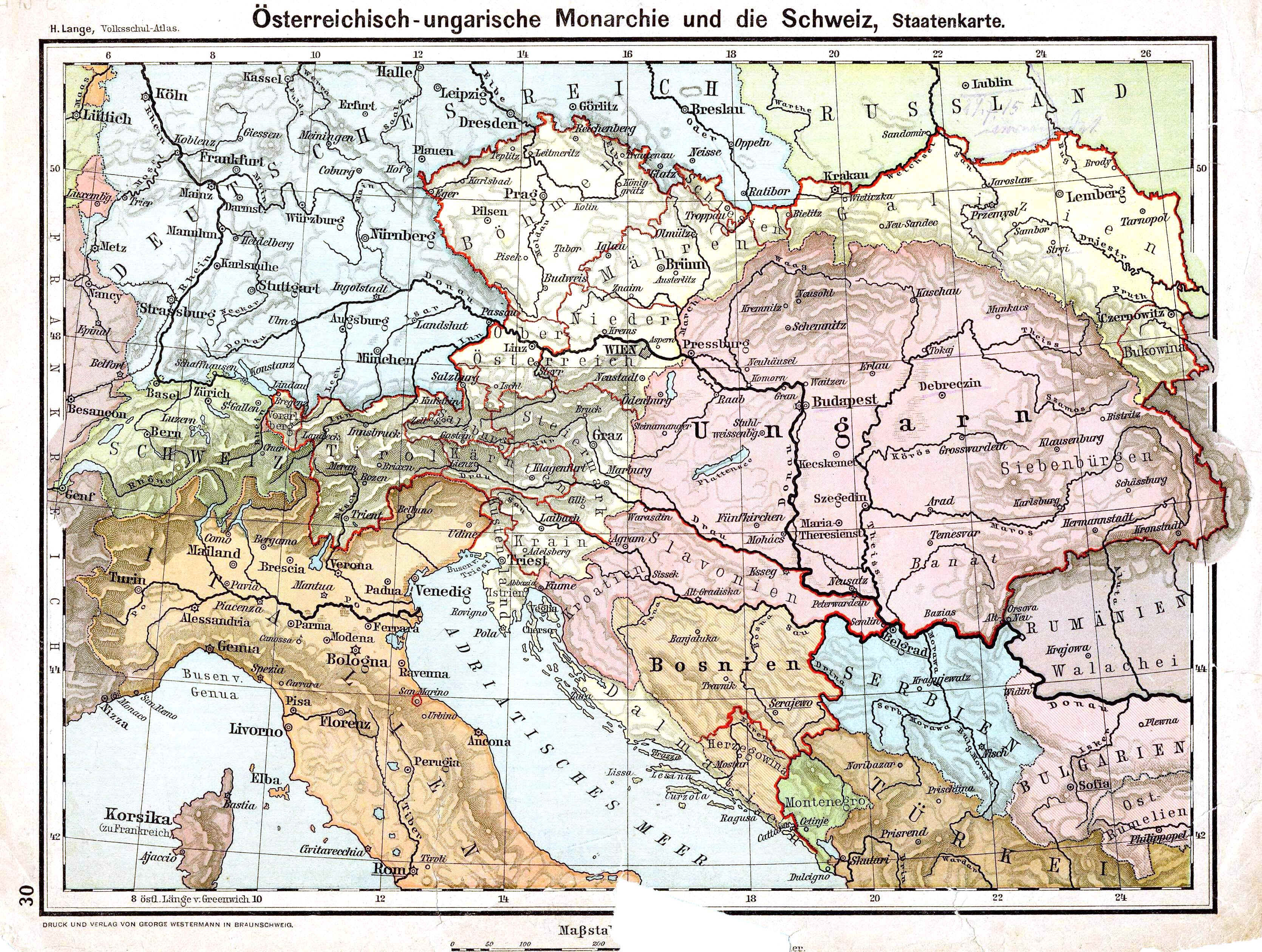 |
|
Hungary (including Croatia)
in 1190, during the rule of Béla
III (orange) |
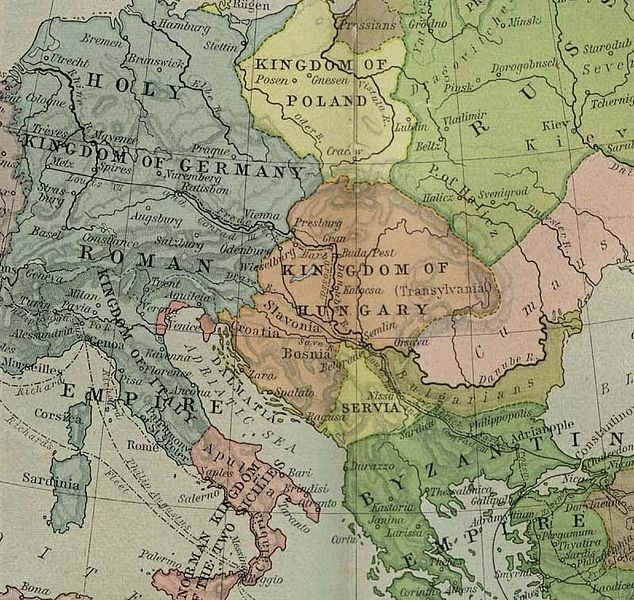 |
| Hungary
in 1490 |
 |
|
Ethnographic map of Hungary without Croatia
and Slavonia (1910). The population of areas under 20
persons/km2 is represented in the nearest area
above that level, and the area is left blank. |
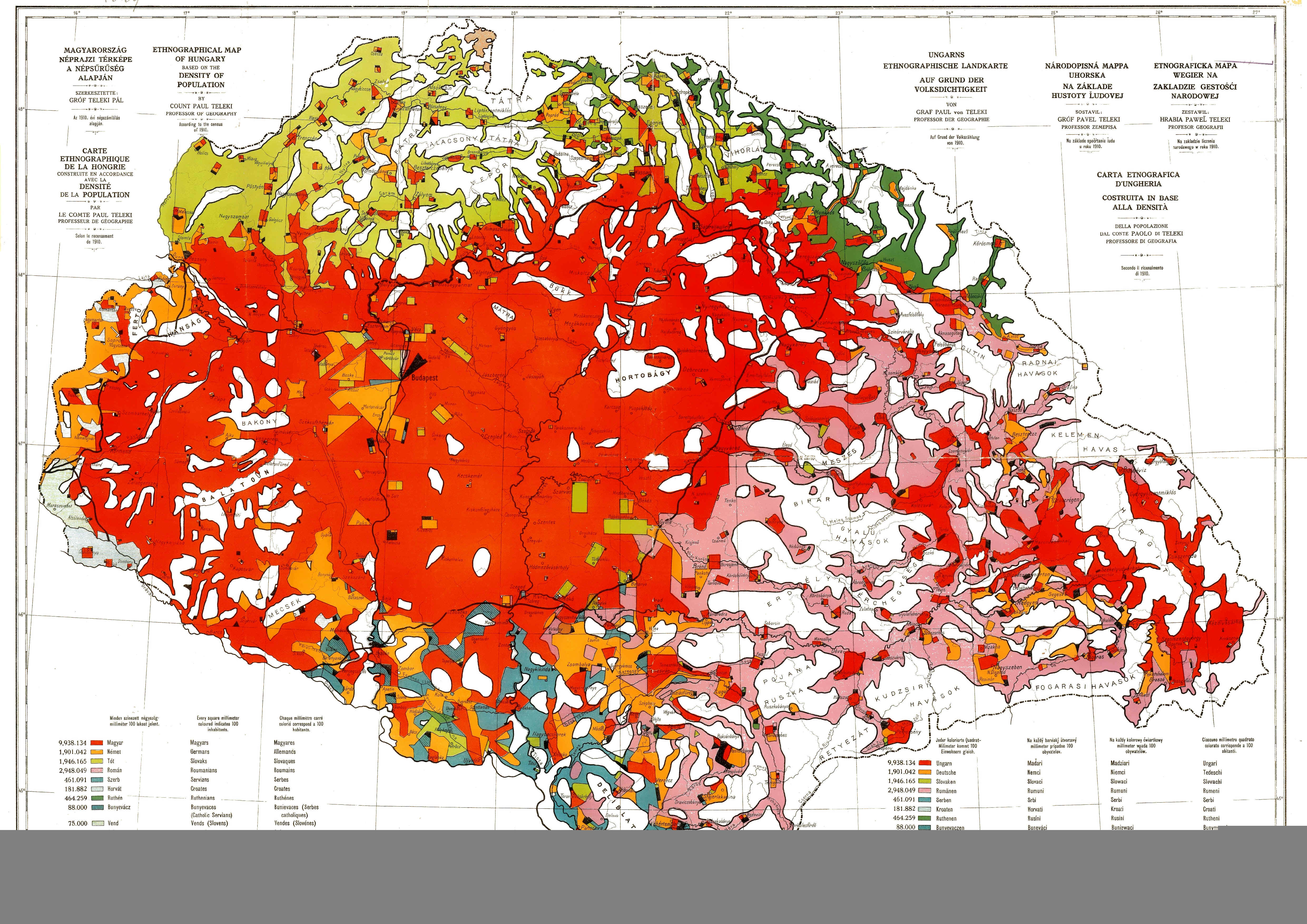 |
|
The Treaty
of Trianon: Hungary lost 72% of its territory, and lost
its sea ports in Croatia. 3,425,000 ethnic Hungarians found
themselves separated from their motherland. Hungary lost
half of its 10 biggest cities and all of its precious metal
mines |
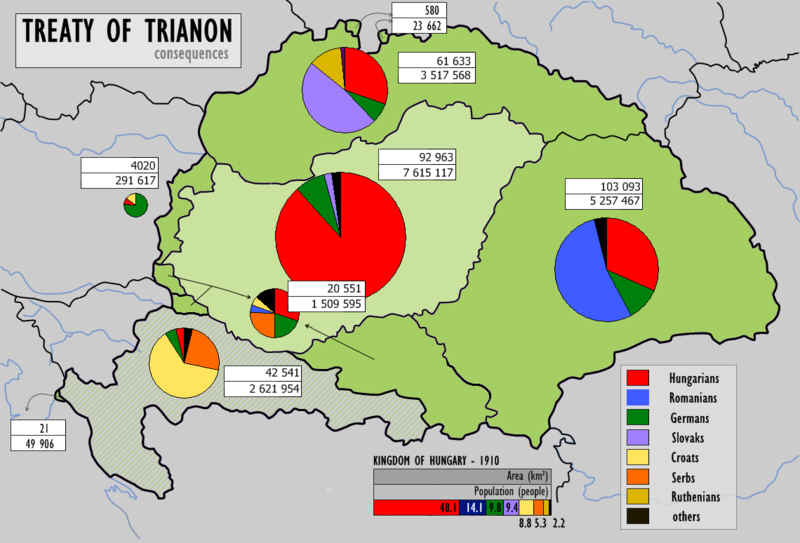 |
| |
|
|
| The Magyars
A Thousand Years of
Hungary
http://hungarianhistory.freeservers.com/magyars.html |
Magyar
Origins
When the
Magyar people entered the land of Europe, they seemed a part of
the Turkic hordes roaming between South-Eastern Europe and
Central Asia. Greater evidence points to Asia as the Magyar's
original homeland. Exactly what part of Asia has been a matter
of dispute for generations, but it is clear that the Magyars
came from the East. The horse was the most important animal to
the Magyars. They both traveled and fought on horseback during
their long migrations from the east and eventually into what is
present day Hungary. Their weapons and style of fighting were
identical with those of the Huns, Avars and other mounted
nomadic peoples. But the Magyars were a distinct group separate
from the Huns, Avars and Turks.
Finno-Ugrian
Theory
The most
widely accepted theory of the Magyar's origin is the
Finno-Ugrian concept. Advocates of this theory believe the
linguistic and ethnic kinship between the Hungarians and the
Finns, Esthonians, Ostyaks and Voguls provide evidence for the
origin of the Magyars. This relation of the Magyars with the
Finns places the ancient homeland of the Finno-Ugrians on both
sides of the southern Ural Mountains. The advocates of this
theory insist that Magyars came from this group in the Urals,
and as the theory explains, it was about 2000 B.C. that the
Finnish branch broke away to settle in the Baltic area. The
Magyars remained on the West Siberian steppes with the other
Ugrian peoples until 500 B.C. It was then that the Magyars
crossed the Urals westward to settle in what is present day
Soviet Bashkiria, north of the Black Sea and the Caucasus. The
Magyars remained here for centuries with the various Ural-Altaic
peoples such as the Huns, Turkic Bulgars, Alans and Onogurs. The
Magyars soon adopted many cultural traits and customs of these
people and it was from the region of Soviet Bashkiria that the
Magyars started their migration westward toward the Carpathians.
After
World War II, the Finno-Ugrian theory was challenged by scholars
who argued that the Finno-Ugrian theory was based on linguistics
alone, without support in anthropology, archeology or written
records.
Orientalist
Theory
Scholars
known as orientalists believe that the origin of Magyars and
their language is not found in the Urals, but in Central Asia
known as the Turanian Plain or Soviet Turkestan which stretches
from the Caspian Sea eastward to Lake Balchas. Ancient history
has traditionally called this region Scythia. Folklore holds
that the Magyars are related to the Scythians who built the
great empire of the 5th century B.C. After the Scythian empire
dissolved, the Turanian Plain witnessed the rise and fall of
empires built between the first and ninth centuries A.D. by the
Huns, Avars, Khazars and various Turkic peoples, including the
Uygurs. The Magyars subsequently absorbed much of the culture
and tradition of these peoples and many Onogur, Sabir, Turkic,
and Ugrian people were assimilated with the Magyars, resulting
in the Magyar amalgam, which entered the Carpathian Basin in the
later half of the ninth century A.D.
Scholars
of Far Eastern history believe that the Magyars were also
exposed to the Sumerian culture in the Turanian Plain. Linguists
of the 19th century, including Henry C. Rawlinson, Jules Oppert,
Eduard Sayous and Francois Lenormant found that knowledge of the
Ural-Altaic languages such as Magyar, helps to decipher Sumerian
writings. Cunei form writing was found to be used by the Magyars
long before they entered the Carpathian Basin. The similarity of
the two languages has led orientalists to form a
Sumerian-Hungarian connection. The orientalists speculate that a
reverse of the Finno-Ugrian theory may be possible. The theory
holds that if the proto-Magyars were neighbors of the
proto-Sumerians in the Turanian Plain, then the evolution of the
Hungarian language must have been a result of Sumerian rather
than Finno-Ugrian influences. The theory in turn holds that
rather than being the recipients of a Finno-Ugrian language, it
was the Magyars who imparted their language to the Finns and
Estonians without being ethnically related to them. What
scholars site for added evidence for this theory is the fact
that the Magyars have always been numerically stronger than
their Finno-Ugrian neighbors combined. The theory believes that
the Finns and Ugors received linguistic strains from a Magyar
branch who had broken away from the main body on the Turanian
Plan, and migrated to West Siberia.
The
Magyar-Uygur Theory
The
connection between the Magyars and the Uygurs tie Hungarians
even closer to Asia. The Uygurs are people who live in the
Xinjiang province of China. The Uygurs are Caucasian in
appearance and maintain a Turkic language. To the north of the
Uygar's border stretches the Dzungarian Basin which has a
striking similarity to the word Hungarian. Northeast of the
Dzungaria lies the Altai Mountain Range, a name used by
linguists to define the Ural-Altaic language group to which the
Magyar language belongs. Further up to the north stretches the
Lake Baykal region where first the Scythians, then the Huns
emerged to conquer the Turanian Plain. The Magyars, Uygurs and
the Turks may also have started their migrations from the
northeastern part of the Baykal area.
Further
anthropological, archeological and linguistic research must be
conducted on this theory, but is limited by the little access
the Chinese government grants foreigners to the region. There
are, however, many Asiatic influences seen among Hungarians
today. Hungarian legends and folk tales are strikingly similar
to those of Asian peoples. The structure of Magyar folk music,
which uses the pentatonic scale, also points to Asian origins.
The beautiful gates of the Székely people in Transylvania bear
a strong resemblance to those in the pagodas of China. The
ornate tombstones carved from wood are also similar to those
seen in Chinese cemeteries. The Hungarian cuisine shows traces
of Asia in its use of strong spices such as paprika, pepper,
saffron, and ginger.
The
Hun-Avar Theory
Much of this
theory has been perpetuated by folk tale. Most Hungarians today
can tell the story of the Legend of the White Stag. The story
describes how two sons of Nimrod, Hunor and Magor, were lured
for days into a new land by a fleeing white stag. The stag
suddenly vanishes without trace. But the disappointed young
hunters hear laughing and singing. The two dismount and follow
the laughing until they come across a lake in which two
beautiful maidens are splashing. The two hunters take the
maidens as wives. The Huns are Hunor's descendent, and the
Magyars are Magor's descendents. There are variations on the
folk tale including Simon Kézai's version in his 1283
chronicle, Gesta Hungarorum. The same mythical tale takes on a
slightly somber and more realistic approach. Hunor and Magor are
Chief Ménrót's grown up sons who had reached maturity and had
moved into a separate tent. "One day it happened that, as
they were going out to hunt, a hind suddenly appeared in front
of them on the plains, and as they undertook to pursue her, she
fled from them into the Maeotian marshes. Since she completely
disappeared there from their eyes, they searched for her a long
time but could not chance upon her traces. After having
traversed the said marshes, they decided the marshes were
suitable for raising livestock. They returned to their father,
and securing his consent, they moved into the Maeotian marshes
with all their animals to settle down there. The region of
Maeotis is a neighbor of Persia. Apart from a very narrow wading
place, it is enclosed by the sea everywhere. It has absolutely
no streams, but it teems with grass, trees, fish, fowl, and
game. Access to and exit from it is difficult. Thus settling in
the Maeotian marshes, Hunor and Magor did not move from there
for five years. In the sixth year they wandered out, and by
chance they came upon the wives and children of Belárs sons,
who stayed at home without their men folk. Quickly galloping off
with them and their belongings, they carried them off into the
Maeotian marshes. It so happened that among the children they
also seized the two daughters of Dula, the Prince of the Alans.
Hunor married one and Magor the other. All the Huns descend from
these women."
From Hunor
came the great and dreaded leader Attila. After the kingdom of
Attila fell apart shortly after his death, further waves of
people moved in to the Carpathian Basin but all were crushed by
the Avars, a quickly emerging branch of the Ural-Altaic group.
The Avars founded and empire on top of what used to be
Attila's-the region between the Danube and the Tisza rivers. The
Avars even used a weapon perfected by the Huns, the curved sabre
gladicus hunnicus. The Avars downfall, however, was hastened by
the development of Charlemagne's Frankish Empire. The Avars and
Charlemagne's army went to battle from 796 to 803 A.D. The Avars
were finally defeated by the Frankish troops and most Avar
tribes returned to the slopes of the Caucasian Mountains. Others
stayed and mingled with the Slavs of the area and later with the
Magyars. When the Magyar tribes arrived under Árpád, they
found a sparse population including many Avars. According to the
Teri-i-Üngürüsz chronicle, "When they arrived in the
land, they saw its many rivers teeming with fish, the land rich
in fruits and vegetables, and members of other tribes, some of
whom understood their language."
This
theory of Hun-Avar-Magyar progression into the Carpathian Basin,
however, is only part of the story.
Black
and White Magyars
The Chinese
believed that there were five cardinal directions, the fifth
being "the center of the universe", China itself. Each
of the five directions was symbolized by a color. The central
point, China, was indicated by yellow, for the gold that befit
His Imperial Highness. The North, shrouded in dark Arctic
nights, was black. The West was designated as white, a color
that reflected the blinding white sands of the vast deserts on
the western horizon. Red represented the sun of the South, and
the East was symbolized by blue, the color of the ocean
eternally washing China's eastern shores.
Based on
these color symbols, the White Magyars (or White Ugurs)
represented the Western branch of their race. According to
ancient Russian chronicles, the White Magyars appeared in the
Carpathian Basin as early as 670-680 A.D., first with the
Bulgars, and later with the Avars. The second branch of Magyar
tribes-called Black Magyars in ancient Russian chronicles-took a
different route. The directions of that route are still debated
by Finno-Ugrian and orientalist theorists, but the end result
was that the Black Magyars became connected with peoples
belonging to the Ural-Altaic groups. These included a range of
peoples from Manchuria to Turkey.
Among
these groups the Finno-Ugrian/Magyars drew closest to the Turks,
who were warriors with a talent for statecraft. This association
with the Turks created a new blend of Magyar: Finno-Ugrian in
language but Ural-Altaic in culture. This was the strain of
Magyars that in 895 A.D. would ride into the Carpathian Basin
under Árpád-following the footsteps of the White Magyars who
appeared in the Carpathian Basin in the 670s A.D. Árpád's
Magyars has been termed by some modern historians as the second
wave in a two-phased conquest of the Hungarian homeland. Whether
this theory is correct or not, it seems fairly certain that the
Szeklers (székelyek) had been long-time inhabitants of
Transylvania before the Magyars arrived.
Sources:
István Lázár, "Hungary: A Brief History" Corvina
Books, Budapest: 1990, pp. 11-35.
Stephen Sisa, "The Spirit of Hungary" Vista Books, New
Jersey: 1995, pp 1-6.
|
| |
|
|